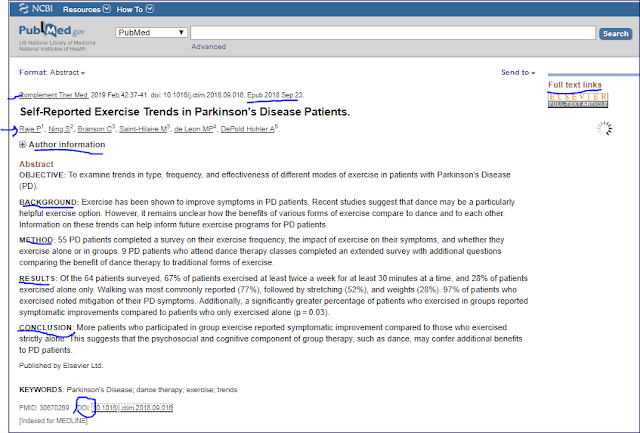Sometimes research reports are really full of jargon and hard to read. But I've found some tricks that help me understand them better. (Evaluating them will be in a separate blog post.)
I spend a lot of time on Pubmed.gov, because most research is available there. (Google Scholar includes little of the research, so I avoid it.) What's available here are abstracts (summaries) of research, and sometimes links to the full articles.
Here's an example of a recent abstract that has been marked to help you identify useful information:
Here are a few things that I do:
Read the Conclusion first (not all abstracts contain these helpful headers, but at least the conclusion will be at the end). This tells us that: "More patients who participated in group exercise reported symptomatic improvement compared to those who exercised strictly alone..." Hm, so pwp are doing better in group exercise.
If I want to know more, I move up to Results. This tells me some statistics (which I understand some of the time), and more details than the Conclusion. For instance, 97% of those who exercised improved their symptoms.
How was the study done? How many were involved? For this, I move up to Method / Methods. This tells me and number of patients or healthy people were studied, and what action was taken; in this case, it was a survey.
Background will tell briefly about the reasoning or earlier research that lead to this study.
Up at the top are the title and the authors; if I want to know more about who did the research, I can click on + Author Information (in Pubmed, not in the illustration). At the top is also the journal name and the publication date; often there is an Epub date, date published online, that may be earlier than the "official" publication date. This tells me how recently the work was done.
Often this is enough, but sometimes I want to know more. For instance, how old were the subjects, or what mix of genders. Maybe I want to know more about the methodology that was used. In that case, I need to read the full paper; sometimes I can reach it, either by clicking on Full Text Links (upper right) or on the DOI number (lower left). Since I've had better luck with the DOI number (Digital Object Identifier), if the Full Text Link doesn't say "Free," I click on DOI. Sometimes all that I can find there is the abstract, but sometimes, with some publishers, there is more. Some publishers include Highlights, the essential findings, which can be more useful than the abstract for telling about key findings:
Sometimes I can see the full paper, as in this case; the abstract is at the beginning of the paper, and then the full paper follows.
If I want more, the Discussion section of the full paper often has some of the most interesting material; it's here that researchers often compare their findings to those of different researchers, or reflect on what their results mean.
Sometimes the full paper is behind a Paywall; that means I need to be a subscriber to the journal or a medical/scientific database of these articles, or be willing to pay around $35 to read the paper - which I'm not. If you think you'll routinely want to read whole papers, cultivate a friend or family member who has access to these articles for their work, perhaps somebody in the scientific or medical field.
I'll be explaining how to evaluate a paper in a future blog post. For now, post a comment if you have a question, so that I can reply.
Subscribe to:
Post Comments (Atom)
Great tools to use during the Pandemic
Some organizations have stepped up for pwp who have lost socialization, and usually exercise programs and support groups. Even for those ex...

-
Looked into Marty Hinz and his amino acid supplementation, as I look into just about anything that might make PD easier. I have to say ...
-
On his videos, Lonnie Herman swears that he's got the cure for Parkinson's, cancer, interstitial cystitis, you name it. He uses...
-
There are members of the PD community who are convinced that following a ketogenic diet will slow progression. I had my doubts, but figured...





No comments:
Post a Comment